Do you want some small, easy to make, succulent planters for your home? Empty wine bottles are one of the most elegant materials you can use! The examples you see below show just how perfectly wine bottles and succulents go together.
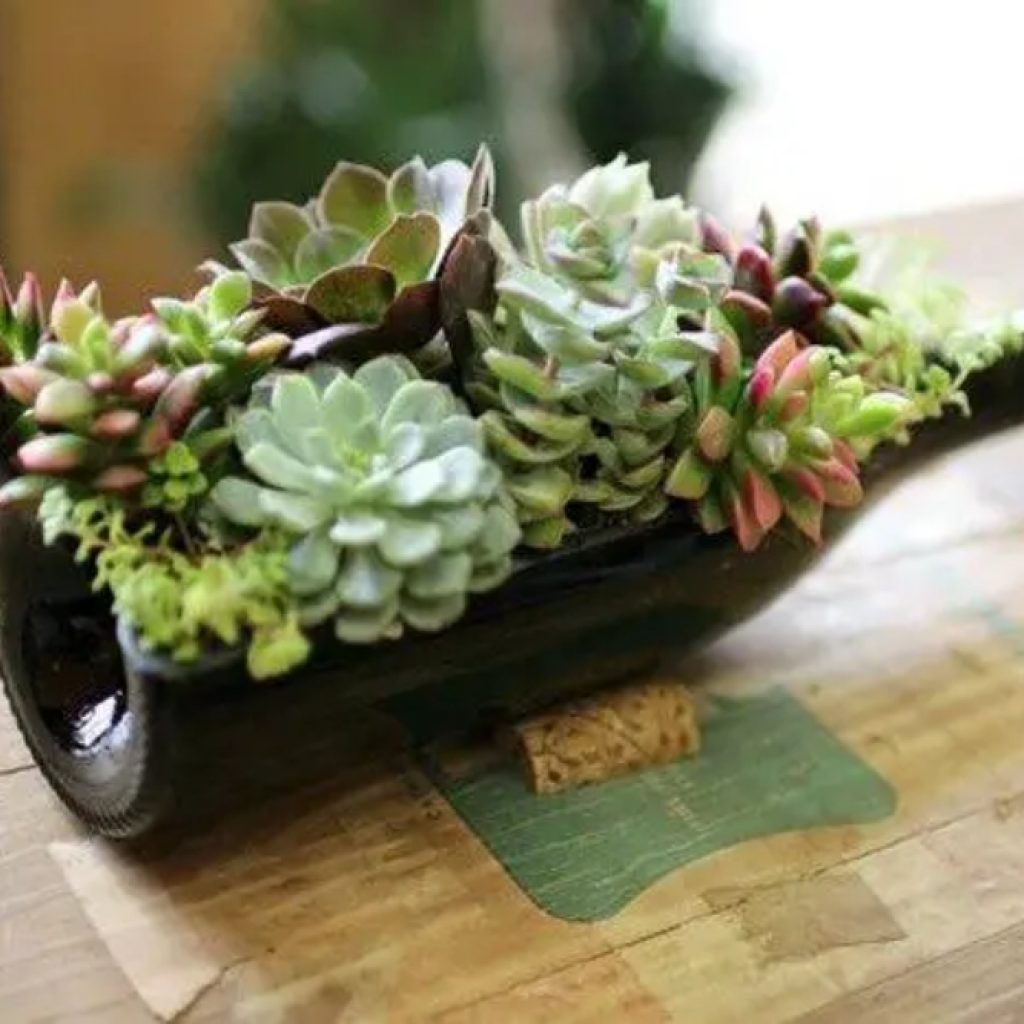
Cutting bottles can be difficult at first. If this is your first time doing a project with glass bottles, you can go with the simplest method of dividing the bottle horizontally as shown in our main image above. Glass bottle planters cut like this can only accommodate one larger succulent at a time.
If you have some experience in glass bottle cutting, then you can cut the bottle vertically so that your bottle planter is lying down with more surface area for more succulents!

Whichever way you choose to cut your wine bottles, it’s always best to use real glass cutters for a cleaner cut. Don’t forget to sand down the edges, too, to avoid injury from your DIY succulent planters.
These wine bottle planters are perfect living decorations at the dining table, coffee table, or kitchen counters. They are also great gift ideas for friends and family!
Is this going to be your next upcycling project? :)
Contents
Creating Wine Bottle Succulent Planters
Materials
- Empty Wine Bottles
- Potting Soil
- Succulents
- Ice Cubes
- Candle
Tools
- Glass Cutter
Instructions
Prepare Your Workspace:
- Find a well-ventilated area with a sturdy work surface.
- Lay down some newspaper or a drop cloth to catch any glass shards.
Clean the Wine Bottles:
- Rinse the wine bottles thoroughly to remove any residue.
- Soak the bottles in warm, soapy water to remove the labels.
- Dry the bottles completely before proceeding.
Mark the Cutting Line:
- Use a marker to draw a line around the wine bottle where you want to make the cut. A common option is to cut the bottle horizontally about one-third from the bottom.
Score the Bottle:
- Position the glass cutter along the marked line.
- Apply even pressure and rotate the bottle to create a score line. Make sure the score line is continuous and even around the bottle.
Heat the Score Line:
- Light a candle and hold the scored line over the flame.
- Rotate the bottle slowly to evenly heat the score line. Continue for about 5-10 minutes.
Cool the Score Line:
- Immediately after heating, place ice cubes along the score line.
- The rapid temperature change will cause the glass to crack along the scored line. You may hear a popping sound as the glass breaks.
Separate the Bottle:
- Gently tap the bottle on a hard surface to fully separate the two halves. If it doesn’t separate easily, repeat the heating and cooling process.
Smooth the Edges:
- Use sandpaper or a sanding block to smooth the cut edges of the glass. This step is crucial to avoid injuries from sharp edges.
Prepare the Planter:
- Place a small layer of pebbles or small stones at the bottom of the cut wine bottle for drainage.
- Fill the bottle with potting soil, leaving about an inch from the top.
Plant the Succulents:
- Carefully remove the succulents from their original containers.
- Arrange the succulents in the soil, ensuring they have enough space to grow.
- Gently press the soil around the roots to secure the plants.
Water the Succulents:
- Use a small amount of water to moisten the soil. Succulents don’t need much water, so be careful not to overwater.
- Place the planter in a location with indirect sunlight.
Click on any image to start lightbox display. Use your Esc key to close the lightbox. 8-)
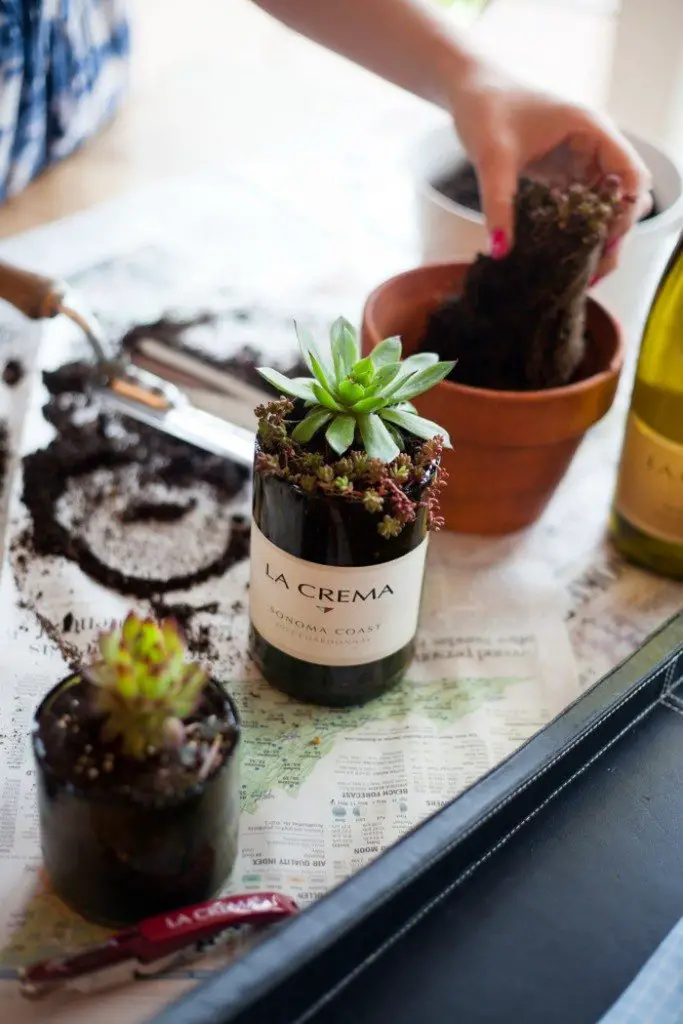
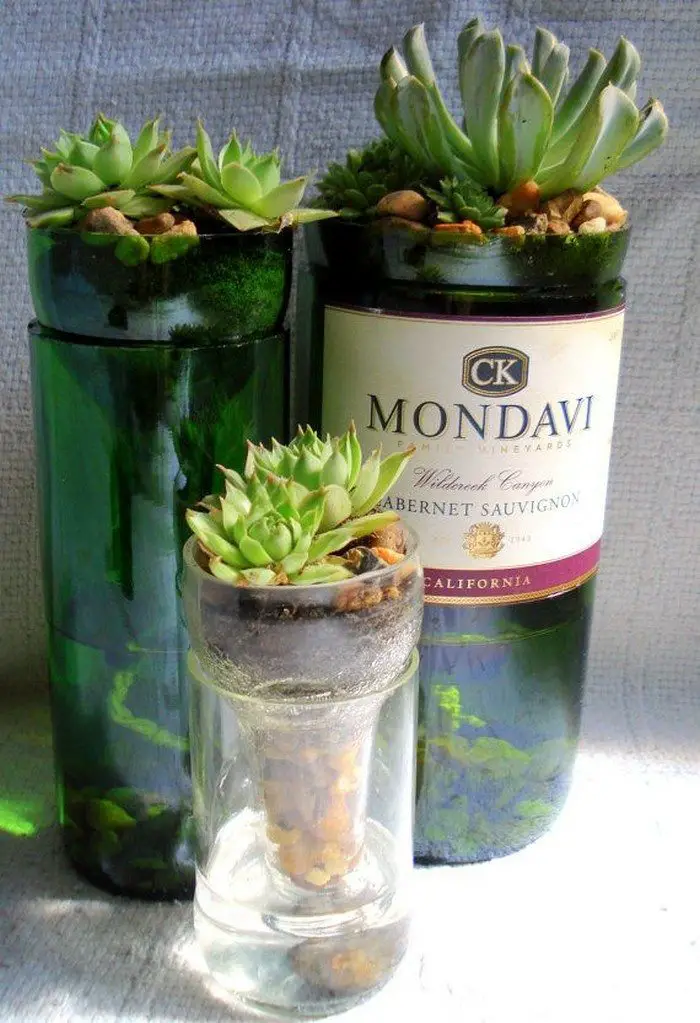
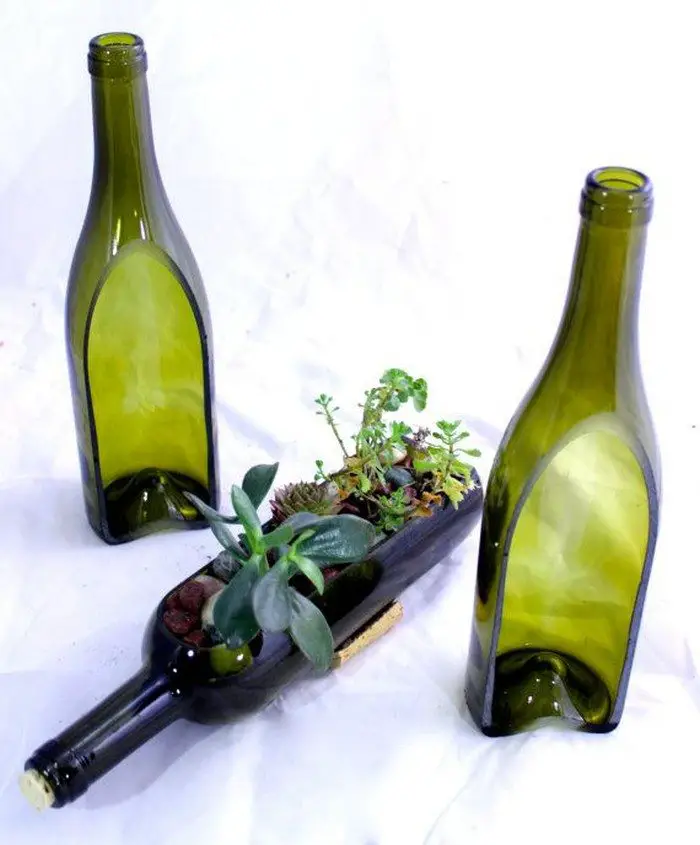
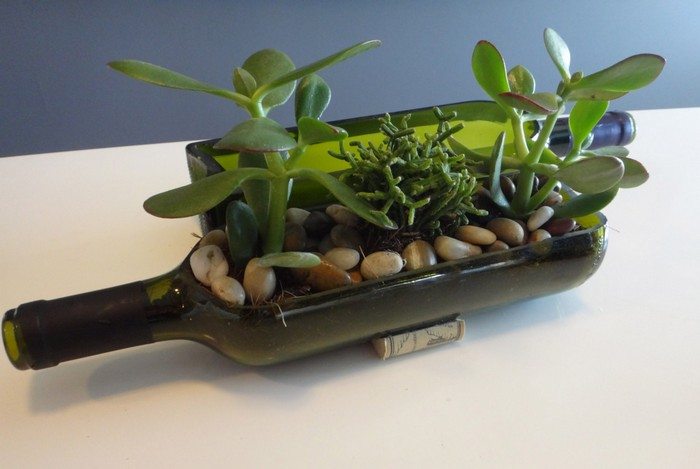
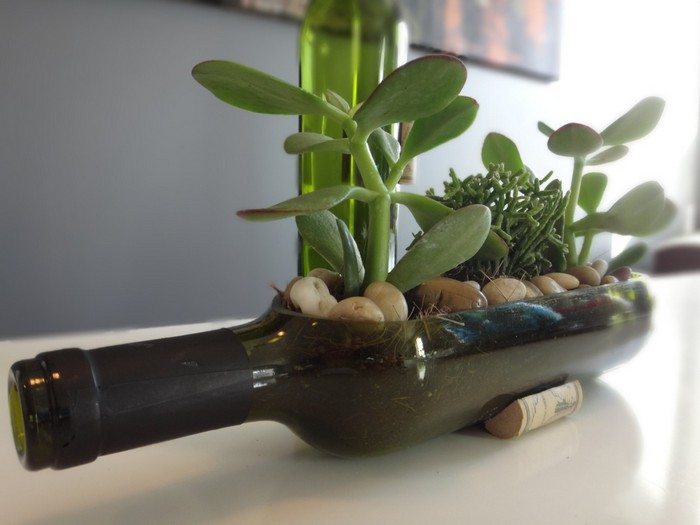

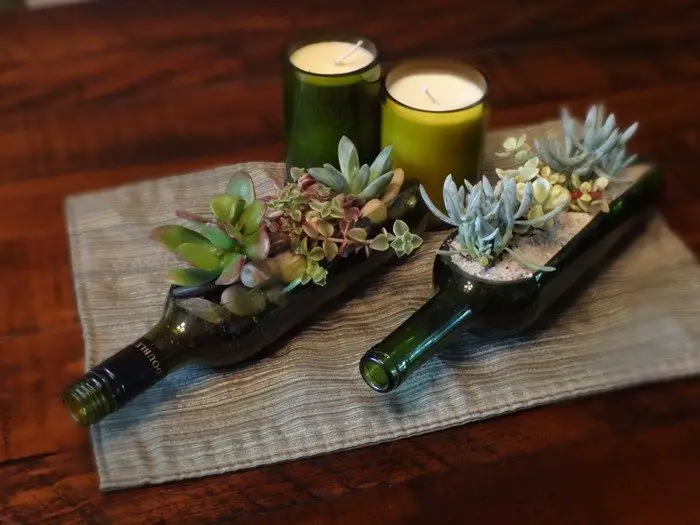
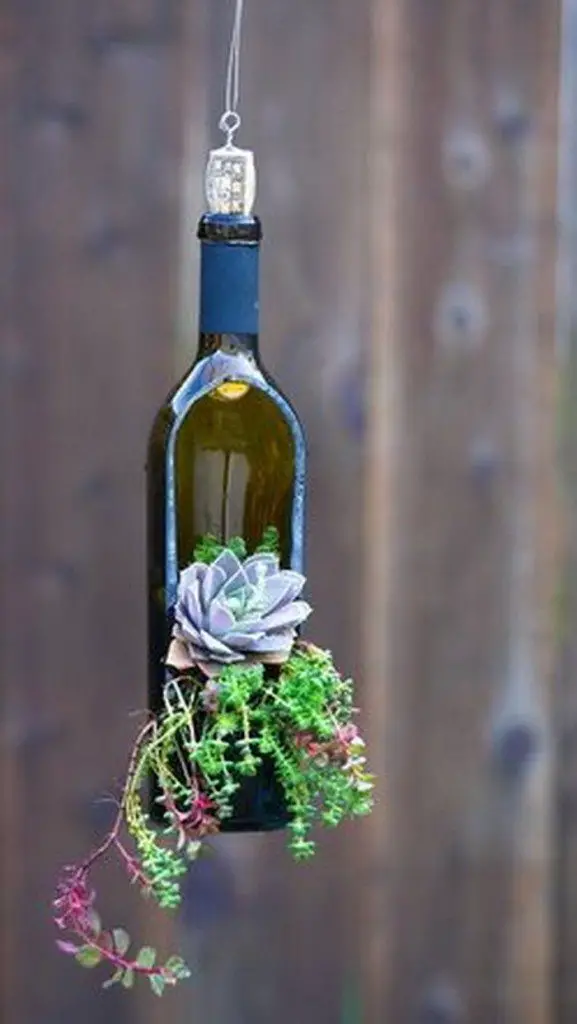
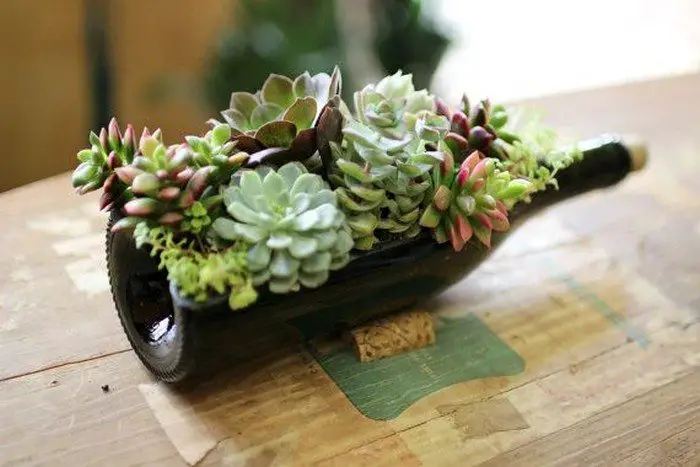
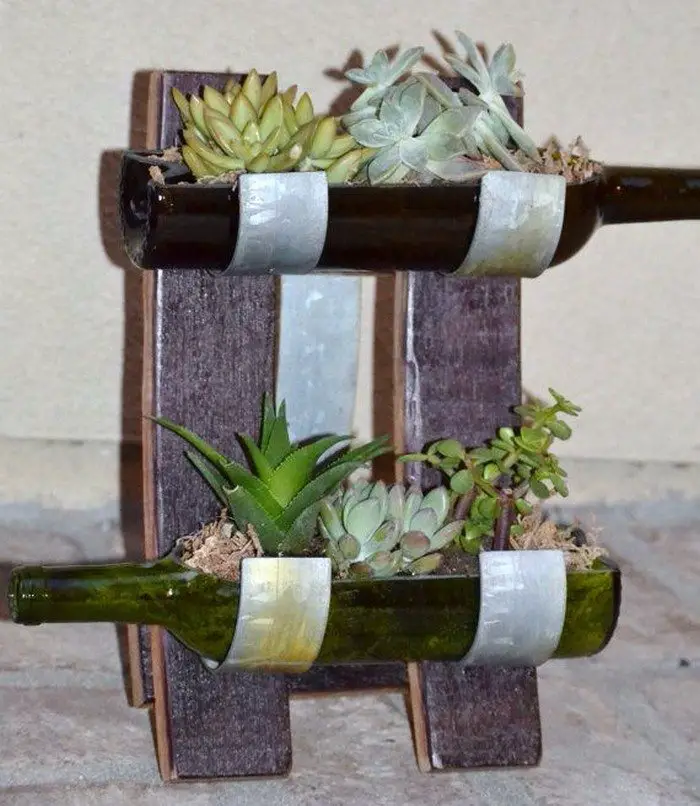
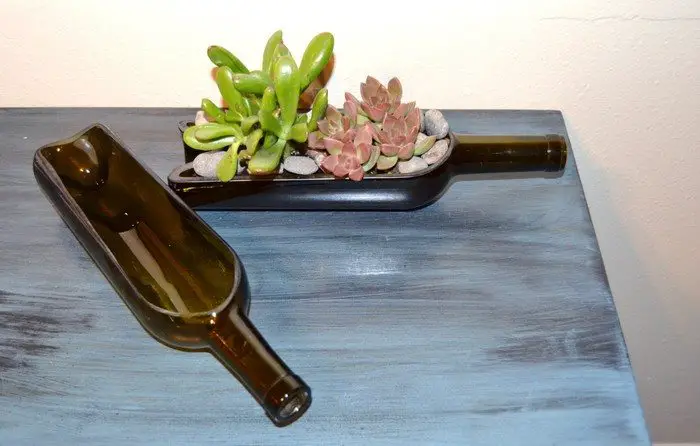

You can get more step-by-step instructions here…
Creative Ways to Use Succulent Planters in Home Décor
Succulent planters offer a versatile and stylish way to bring greenery into your home. These low-maintenance plants thrive in various settings, making them perfect for creative décor solutions. Here are some innovative ideas to incorporate planters into your home décor.
Centerpieces for Dining Tables
Succulent planters make stunning centerpieces for dining tables. Arrange a few planters of different heights in the center of the table to create an eye-catching display. Mix and match different succulents to add texture and color to your table setting.
Wall-Mounted Displays
Transform a plain wall into a living piece of art by creating a wall-mounted succulent display. Use shallow succulent planters mounted on a wooden frame or directly on the wall. This adds a unique, green touch to any room and saves floor space.
Coffee Table Accents
Place small succulent planters on your coffee table to add a touch of greenery to your living room. Combine them with decorative items like candles, books, or trays to create a cohesive and stylish arrangement.
Bathroom Décor
Succulent planters are ideal for bathroom décor because they thrive in humid environments. Place a few small planters on the windowsill, countertop, or shelves to bring a refreshing element to your bathroom.
Kitchen Counter Highlights
Add a pop of green to your kitchen by placing succulent planters on your countertops. They can be arranged near the sink, on a windowsill, or even as part of a herb garden setup. Succulents are easy to care for and add a natural touch to your kitchen space.
Bookshelf Beautification
Incorporate succulent planters into your bookshelf décor. Use them to break up rows of books and add visual interest. Their compact size makes them perfect for small spaces and adds a natural element to your reading nook.
Entryway Elegance
Welcome guests with a touch of nature by placing succulent planters in your entryway. Arrange them on a console table or a shelf near the door to create a warm and inviting atmosphere as soon as you enter the house.
Succulent planters offer endless possibilities for enhancing your home décor. Their versatility and low maintenance make them an excellent choice for any room. Experiment with different arrangements and locations to find the perfect fit for your home.
Troubleshooting Common Problems with Succulent Planters
Because of their low maintenance and distinctive look, succulent pots are becoming more and more popular for indoor gardening. They can nevertheless run across problems though that call for attention. These typical issues and fixes can help you make sure your succulent planters flourish.
Overwatering
One of the most often occurring issues with succulent plants is overwatering. Succulents shouldn’t be kept in always moist conditions; they require well-draining soil. Make sure your planter has appropriate drainage holes and let the soil dry out totally between waterings to prevent overwatering. Indices of overwatering include root damage, a mushy texture, and fading foliage.
Underwatering
Although succulents are drought-tolerant, they still need sporadic watering. Leaves can shrink and turn brittle from underwatering. Water your succulent planters completely but sparingly to help with this. Make sure the water gets to the roots then let the ground dry up before the next irrigation.
Insufficient Light
Succulents require ample sunlight to thrive. Insufficient light can cause them to become leggy and lose their vibrant colors. Place your succulent planters in a location where they receive at least six hours of indirect sunlight daily. If natural light is limited, consider using grow lights to supplement their light needs.
Pests and Diseases
Pests like mealybugs and spider mites can infest succulent planters. These pests can cause damage by sucking the plant’s sap, leading to stunted growth and yellowing leaves. Use insecticidal soap or neem oil to treat infestations. Additionally, ensure proper air circulation around your planters to prevent mold and fungal diseases.
Temperature Stress
Succulents prefer moderate temperatures and can be sensitive to extreme heat or cold. Keep your succulent planters in a stable environment, away from drafts, radiators, and air conditioners. If your home experiences temperature fluctuations, monitor your plants closely and adjust their location as needed.
Poor Soil Quality
The soil used in succulent planters must be well-draining. Regular potting soil retains too much moisture, which can harm succulents. Use a cactus or succulent-specific soil mix, or create your own by combining potting soil with sand or perlite to improve drainage.
Root Bound Plants
Over time, succulents can become root-bound, meaning their roots have outgrown the planter. This can stunt growth and cause health issues. If you notice roots growing out of the drainage holes or the plant becoming top-heavy, it may be time to repot your succulent planters into larger containers.
Etiolation
Etiolation occurs when succulents do not receive enough light, causing them to stretch and grow leggy. This results in long, weak stems and sparse leaves. To correct etiolation, move your succulent planters to a brighter location with more direct sunlight. In severe cases, you may need to prune the elongated growth and allow new, compact growth to develop.
Chemical Sensitivity
Some succulents are sensitive to chemicals found in tap water, such as chlorine and fluoride. This can cause leaf tips to turn brown or leaves to drop. If you suspect chemical sensitivity, use filtered or distilled water for your succulent planters. Allow tap water to sit out overnight to let chemicals dissipate before using it.
Shock from Transplanting
Transplanting succulents can sometimes lead to transplant shock, where the plant experiences stress from being moved to a new environment. This can result in wilting, yellowing, or dropped leaves. Minimize shock by gently handling the roots, watering sparingly after transplanting, and gradually acclimating the plant to its new surroundings.
Leaf Burn
Succulents can get sunburned if exposed to too much direct sunlight too quickly. This results in brown or white spots on the leaves. Prevent leaf burn by gradually introducing your succulent planters to more sunlight, especially if they were previously kept in lower light conditions. Provide some shade during the hottest part of the day if needed.
By addressing these common problems, you can keep your succulent planters healthy and vibrant. Regular monitoring and proper care will ensure your plants continue to be a beautiful addition to your home.
Conclusion
Making lovely planters from wine bottles is a fun and environmentally friendly endeavour. These unusual plants provide any area some elegance and greenering touch. Your succulent planters will flourish and accentuate your house with correct care and imagination.






